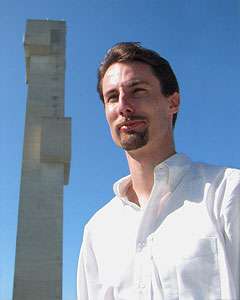Bill Woodcock
| Bill Woodcock | |
|---|---|
|
Bill Woodcock | |
| Born |
16 August 1971 San Francisco, California, USA |
| Occupation | Executive Director, Packet Clearing House |
Bill Woodcock (born August 16, 1971 in San Francisco, California, United States) is the executive director of Packet Clearing House, a non-profit research institute dedicated to understanding and supporting Internet traffic exchange technology, policy, and economics.
Biography
Early Internet years
Bill entered the field of Internet routing research in 1989, while serving as the network architect and operations director for an international multiprotocol service-provision backbone network. In 1993 and 1994, Woodcock was one of the founders of Packet Clearing House, and has served in his current post as Executive Director since 1997. In that time, Woodcock has directly participated in the establishment of more than one hundred and fifty public Internet exchange points in Europe, Africa, Asia, and the Americas. He continues to serve on the boards of, and provide ongoing technical and policy advice to many of these institutions. In 1998, Woodcock and J.D. Falk's model spam regulation became the first anti-spam legislation in the world, California law 17538.4, and paved the way for other jurisdictions. Woodcock has successfully concluded telecommunications regulatory reform efforts in several African countries.
Business ventures
Woodcock has director roles in four companies in the areas of satellite communications, content distribution, and domain name service technology. In 2001 Woodcock co-authored (with Chuck Goolsbee) "Chuck & Woody's Fiendishly Difficult Mac-Mgrs Trivia Quiz" for the annual gathering of member of the Macintosh Managers mailing list in San Francisco for Macworld Expo. To date over 50% of the questions remain unanswered. For more than twenty years, together with Richard Ford and initially Brita Meng, he hosted the annual and inaptly named A/UX User's Group Dinner, in conjunction Mactivity and Macworld meetings.
Boards memberships
- ARIN Board of trustees (since 2002)
- the Internet Capacity Development Consortium[1] (since 2004)
- the .ORG Public Interest Registry Advisory Board 2005-2007
- the board of the ISP/Consortium in 1998 and 1999.
Other affiliations
Woodcock is a current or former Packet Clearing House representative to AFRINIC, APNIC, ARIN, IEPG, ISOC, the ISP/C, LACNIC, NATOA, and RIPE.
Recent activities
Bill Woodcock is a regular speaker at AfNOG, APIA, APNIC, APRICOT, ARIN, ISOC, RIPE, IEPG, IETF, SANOG and NANOG meetings. He has served on the program committees of NANOG, SANOG, PAM, and APRICOT.
Woodcock was one of the two international liaisons in Estonia during the computer attacks unleashed after the Bronze Soldier of Tallinn incident and assisted in the defense coordinated by Hillar Aarelaid and the CERT-EE.[2][3][4]
In the wake of the ITU's December 2012 World Conference on International Telecommunications, which he characterized as an attempted take-over of the institutions of Internet governance, Woodcock published a number of secret ITU budget documents and acted as point-person in an effort to redirect USD 11M in U.S. government funds from ITU contributions to support of the multistakeholder model of Internet governance.[5] This effort centered on a "We the People" petition and an web site, and received much favorable attention in the press and Internet governance community.[6][7]
Books and writings
Woodcock's published work includes many PCH white-papers, the 1993 McGraw-Hill book Networking the Macintosh, the report of the ANF AppleTalk Tunneling Architectures Working Group, which he chaired in 1993 and 1994, many articles in Network World, MacWorld, MacWEEK, Connections, and other networking journals and periodicals.[8] In addition, he was principal author of the Multicast DNS, IP Anycast, and Operator Requirements of Infrastructure Management Methods IETF drafts. In the early 1990s, he pioneered IGP and EGP-based topological load-balancing techniques using IP Anycast technology. Together with Mark Kosters he proposed at the 1996 Montreal IEPG that the root DNS servers be migrated to IP Anycast, and their work has provided the basis upon which root DNS servers have been deployed since the late 1990s.[9] In 2010 and 2011, with Rick Lamb, who had previously built the signing system that places DNSSEC cryptographic signatures on the DNS root zone, Woodcock built the first global-scale FIPS 140-2 Level 4 DNSSEC signing infrastructure, with locations in Singapore, Zurich, and San Jose.[10][11][12][13] In addition to protocol development work, Woodcock has developed networking products for Cisco, Agilent, and Farallon.
Bibliography
- Weller, Dennis and Woodcock, William, "Internet Traffic Exchange: Market Developments and Policy Challenges", OECD Digital Economy Papers, Jan. 29, 2013.
- Woodcock, William and Edelman, Benjamin (Harvard Business School), "Toward Efficiencies in Canadian Internet Traffic Exchange", commissioned by the Canadian Internet Registration Authority, Sep. 12, 2012.
- Woodcock, William and Hernández, Gaël, "Peering in Paraguay: Analysis and Recommendations 2012," Packet Clearing House white paper, Dec. 2012.
- Woodcock, William and Adhikari, Vijay, "PCH Peering Survey 2011", Packet Clearing House survey, May 2, 2011.
- Woodcock, William, "Good Practices in Internet Exchange Point Documentation and Measurement", OECD Directorate for Science, Technology and Industry, Working Party on Communication Infrastructures and Services Policy, May 24, 2007.
References
- ↑ http://www.sanog.org/resources/sanog6/woodcock-icapdev.pdf
- ↑ http://www.nytimes.com/2007/05/29/technology/29estonia.html?_r=1&pagewanted=all
- ↑ http://www.wired.com/politics/security/magazine/15-09/ff_estonia?currentPage=all
- ↑ http://www.ndu.edu/press/estonia.html
- ↑ http://www.forbes.com/sites/eliseackerman/2012/12/14/the-u-n-fought-the-internet-and-the-internet-won-wcit-summit-in-dubai-ends/
- ↑ http://www.zdnet.com/un-plans-internet-governance-amid-outcry-to-defund-itu-7000009882/
- ↑ http://rt.com/usa/news/new-internet-itu-us-160/
- ↑ http://www.politicadigital.com.mx/?P=leernoticia&Article=21023&c=9
- ↑ http://www.nytimes.com/2012/03/31/technology/with-advance-warning-bracing-for-attack-on-internet-by-anonymous.html?_r=2&ref=technology
- ↑ http://www.nytimes.com/2011/06/25/science/25trust.html
- ↑ http://www.circleid.com/posts/20110622_internet_groups_inaugurate_1st_of_three_cyber_security_facilities/
- ↑ http://www.inside-it.ch/articles/25475
- ↑ http://www.computerworld.com.sg/resource/security/internet-groups-provide-cryptographic-security-in-singapore/
External links
- PCH corporate bio
- GPG public key
- IEEE Spectrum biographical article
- ARIN Board of Trustees biographical statement
